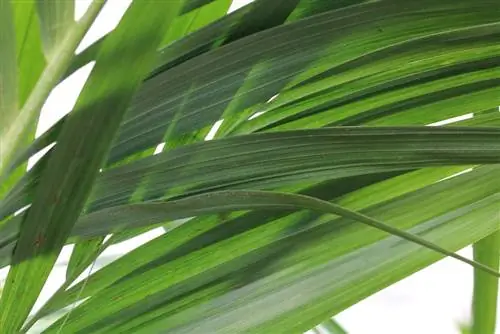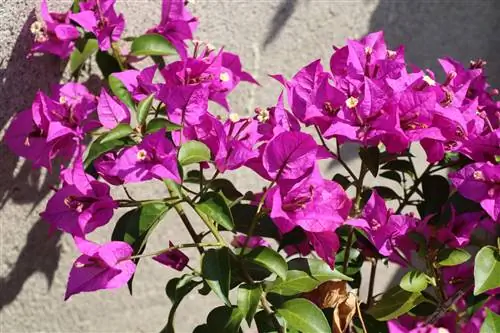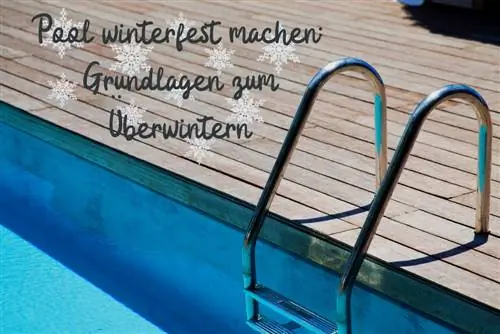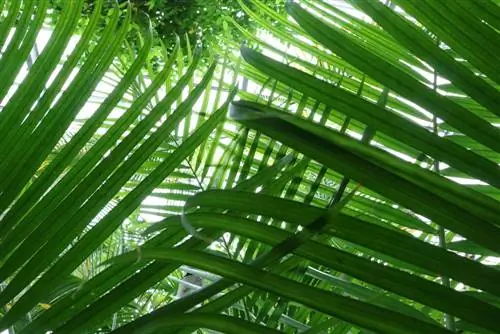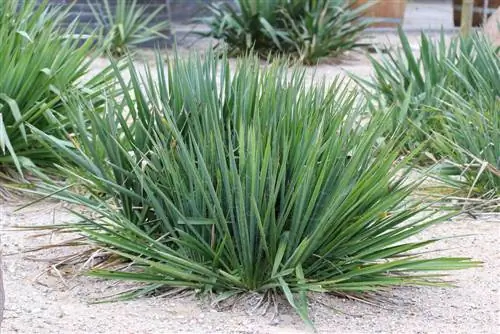- Author admin [email protected].
- Public 2023-12-17 03:39.
- Last modified 2025-01-24 12:45.
The Kentia palm is a very slow-growing feather palm. It is one of the easy-care palms and is originally native to the Lord Howe Islands near Australia. There the palm tree can reach a height of 15 to 17 meters. As a houseplant it grows to around 2 meters high.
The botanist distinguishes between two varieties that are suitable for keeping as potted plants in the room. This is the Howea forsteriana and the Howea belmoreana. For the layperson, the difference can hardly be seen with the eye. The leaves of Howea belmoreana are completely smooth on the underside, while Howea forsteriana has rough undersides. It also has wider fronds and produces strong plants. The palm tree owes its name to its origins on the Australian Lord Howe Island, whose capital is Kentia. Kentia palms grow very old and reach a height of two to three meters. They are a purchase for life.
Location
The Kentia palm prefers a partially shaded location. It doesn't like long-term direct sunlight, but it does need a lot of light. If it is too dark, it will not grow or will grow poorly. Kentia likes it warm in summer. Then you can put them outside, but not in the sun. The palm tree also likes it to be warm in winter. The temperature should not fall below 15 ºC. In the room, the Kentia palm can also be placed a little away from the window. Only in winter do you move them close to the window.
In summer it can be placed a little further into the room, but in winter it is advisable to place it near the window. If it is warm enough outside, Kentia palms can be placed outdoors. Direct sunlight must be avoided at all costs, otherwise the leaves will turn brown or spotty. The palm trees cannot tolerate freezing temperatures. They are overwintered at 15 to 18 degrees, very young plants need a few degrees more.
Planting substrate
The Kentia planting substrate should be permeable and slightly acidic. Nutrient-rich soil is beneficial. A drainage layer at the bottom of the pot makes sense. This allows excess irrigation water to drain away. Coasters must be checked after watering to ensure no water remains. The palm tree is repotted every two to three years. Palm trees have taproots and therefore feel most comfortable in a taller pot.
Care
The water requirement of howea forsteriana is not high. The bale should be kept only moderately moist, but very evenly. This palm also doesn't like hard water. Over time the plant will die. If the plant is too wet, it will also die. Standing water is absolutely harmful.
Brown leaf tips usually come from too little humidity. You can cut them off, but you have to leave a narrow edge, otherwise you will inflict a wound on the palm and the leaves will continue to brown. This can be remedied by regularly spraying with lime-free water. Withered leaves are cut off at the bottom of the stem. Leave about 1 cm of petiole standing. This is how a real tribe forms over time.
- Bright location without sunlight
- Put outside in summer
- Water a lot in summer
- Regular fertilizer applications
- Repot every two to three years
Fertilize
During the main growing season, the Kentia is fertilized every 2 to 3 weeks with a fertilizer for flowering plants or green plants. It should be rich in nitrogen and potassium to promote the development of new shoots. Alternatively, slow-release fertilizer can also be used.
Wintering
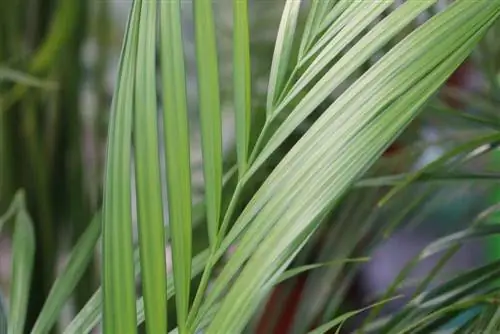
Wintering usually takes place in a living space. The plant copes quite well with dry heating air if it is sprayed every now and then. You use lime-free water, preferably rainwater. The plant should be placed by the window so that it gets enough light. Watering is more economical. The cooler the palm tree is, the less you have to water it. The plant ball must not dry out. Standing water must be avoided at all costs. During the winter you have to check the howea forsteriana regularly for pests. Spider mites, aphids and mealybugs like to spread. The palm tree is often sensitive to chemical sprays. It's better to try collecting and showering first.
Grow from seeds or buy ready-made
Growing from seeds is possible, but it takes a long time for the seeds to germinate and the first leaves to appear. Very fresh seeds must be used, which are best purchased from garden retailers. A cultivation tray for the window sill is well suited for cultivation. The seeds are placed in special growing soil and germinate at sufficiently high temperatures. They should be at least around 25 degrees Celsius.
It is easier to buy young Kentia palms. They are usually cheap and grow into magnificent plants over time. Of course, adult plants are also available commercially, but such specimens come at a price.
A 50 to 60 cm high Kentia palm costs between 10 and 15 euros. You can often buy large specimens cheaply. However, they are often driven unnaturally quickly and show signs of curing. Such plants are better left standing. The plant must look fresh and strong. The tips of the leaves must not be wilted.
Watering regularly
Regular watering is very important. The plant ball must never dry out completely. In summer, watering must be frequent in the morning and evening, but waterlogging should be avoided. Occasional immersion baths, in which the pot is placed in a bucket of water for some time, ensure that the soil is well moistened. To increase humidity, the leaves are sprayed with water several times a week. But be careful, the leaves shouldn't get too wet so that they don't change color. Especially in winter, when the air is very dry due to central heating, spraying helps to keep the plant he althy. In the cold season you water less and only give enough water to ensure that the plant ball does not dry out.
So that the Kentia palm thrives, it is treated with fertilizer once every week in the summer months. Special fertilizer for palm trees is commercially available. Fertilization should not be carried out in the winter months as the plant grows very little during this time and needs a break to recover. If the root ball becomes too large, repotting is necessary. Every two to three years the Kentia palm gets a new pot and new palm soil. The new pots should be very high and always have two to three centimeters more diameter than the old pots. Good water drainage in the soil prevents the roots from suffering from waterlogging.
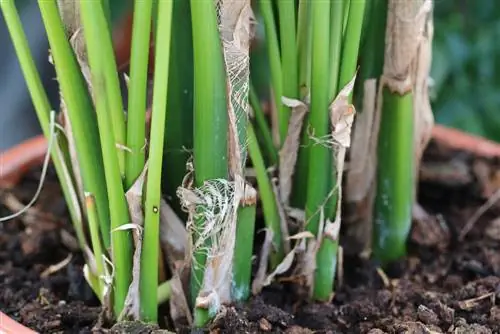
Unfortunately, the Kentia palm is often plagued by pests. Scale insects, mealybugs and spider mites mainly occur when the environment is not ideal. A good location is therefore the best plant protection. Make sure there is good air circulation. If the plants are not too crowded, the pests cannot spread as quickly. Strong plants are less damaged by the infestation than those that are already weakened. The Kentia palm is sensitive to pesticides. They may therefore only be used to a limited extent. To remove the pests, the leaves should simply be washed off. A shower with the shower head rinses off a large proportion of the pests. The gardener has to deal with the rest with a damp cloth. Dissolved curd soap removes many pests, but it should only be used sparingly so that the leaves do not suffer from the action. Collecting them by hand also helps, especially with lice.
Measures in case of pest infestation
- Shower plant
- Soap the leaves
- Collect pests by hand
- Use chemical pesticides very sparingly
Summary
- Like many other palm trees, the Kentia palm does not need a lot of water.
- The bale should only be kept moderately moist.
- But the earth must never dry out. Occasionally you can place the plant in a bucket of water so that it can soak up properly.
- Plants don’t like hard water. In winter watering is done very sparingly. On hot summer days and in centrally heated winter rooms you can spray the palm tree with boiled or distilled (due to limescale stains) water.
- Fertilization is carried out once a week from March to August with liquid fertilizer.
- Brown leaf tips can be cut away. However, you should be careful not to cut into he althy tissue. Withered leaves are cut off at the bottom of the stem. You leave about a centimeter of the leaf stem so that a real trunk can form over the years.
- When repotting older plants, you can trim the roots, then the palm tree will grow more slowly. It should be repotted every two to three years.
- The Kentia palm is propagated by palm seeds. You should know that the seeds only retain their ability to germinate for a short time. The seeds need to be soaked in water for 2 days. The seed container must be kept warm, ideally at 25 to 30 degrees Celsius. It can take months for the seeds to germinate.
- Leaf spots and brown leaf tips are usually caused by the air temperature being too low or by the proximity of the heater.
The Kentia palm is often plagued by scale insects. To combat these pests, rub the underside of the leaves with a cotton swab soaked in alcohol until the creatures have disappeared. Spider mites, mealy bugs and thrips can also appear. The Kentia palm is sensitive to chemical sprays. You should try scraping and showering first.

